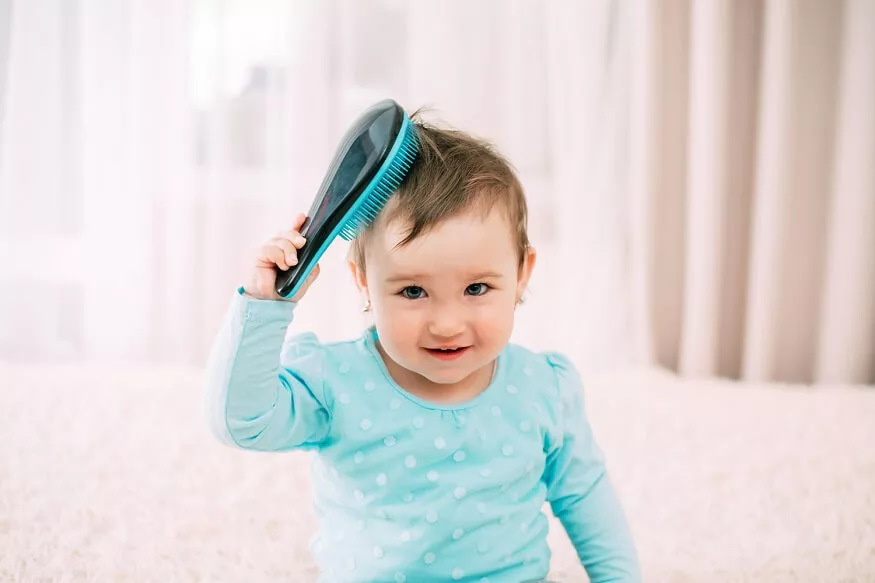What Is a Newborn Cradle Cap?
Cradle cap is a common skin problem affecting newborns. This condition can be identified by the presence of yellowish, greasy, and scaly patches on the baby’s scalp. Although cradle cap is generally harmless and temporary, it can cause concern among parents. In this blog, we will explore cradle cap causes, cradle cap treatment and signs of cradle cap.
Cause Of Cradle Cap In Infants
Here are some cradle cap causes in infants.
1. Overactive Sebaceous Glands:
A newborn cradle cap is frequently linked with excessive sebaceous gland activity in a child’s skin. Sebaceous glands produce an oily substance called sebum, which may gather on the scalp when they are overactive. Excess oil, when combined with dead skin cells, causes the formation of different scales.
2. Maternal Hormones:
Newborn Cradle cap caused by maternal hormones. During pregnancy, a mother’s hormones can influence the baby’s system. This hormonal transfer, occurring in the final months of pregnancy, can stimulate the baby’s oil glands. The increased production of oil can contribute to the development of cradle caps shortly after birth.
3. Yeast Growth (Malassezia):
The presence of a yeast called Malassezia on the skin is normal for many individuals, including infants. However, an overgrowth of this yeast can play a role in the development of cradle caps. The yeast interacts with the natural oils on the baby’s scalp, leading to the formation of scales.
4. Lack of Regular Hair Washing:
Infant scalps are not typically washed as frequently as those of older children or adults. The accumulation of natural oils and dead skin cells due to infrequent washing can create an environment conducive to the development of cradle caps.
5. Immature Immune:
The child’s immune system is still developing during the early months of life. The immaturity of the immune system may contribute to an increased susceptibility to conditions like cradle cap. As the immune system strengthens, the likelihood of developing a cradle cap decreases.
6. Weather Conditions:
Certain environmental factors, such as cold or dry weather, can contribute to the development or exacerbation of cradle caps. Dry conditions may lead to increased skin flakiness, making the scales more noticeable.
7. Genetics:
There may be a genetic predisposition to newborn cradle cap. If a baby’s parents or siblings had cradle caps as infants, there might be a higher likelihood of the condition occurring in subsequent generations.
8. Presence of Malassezia Fungi:
Malassezia fungi, which naturally inhabit the skin, are believed to play a role in the development of cradle caps. These fungi thrive on the oils produced by the sebaceous glands, contributing to the formation of scales.
9. Allergic Reactions:
Some experts suggest that cradle caps may be associated with an allergic reaction to certain substances. However, more research is needed to fully understand the relationship between allergies and the development of cradle caps.
10. Hormonal Changes in the Baby:
Beyond maternal hormones, the baby’s hormonal fluctuations, especially during the first few months of life, may contribute to the development of cradle cap. These hormonal changes can influence oil production in the baby’s skin.
Also Read: Which nutrients help our hair growth?
Recognising the Signs of Cradle Cap:
● Scaly Patches:
The hallmark sign of a cradle cap is the presence of scaly patches on the baby’s scalp. These patches can vary in size and are often yellowish or brownish. The scales may appear greasy or crusty.
● Redness and Irritation:
Alongside the scaly patches, the cradle cap may cause redness and mild irritation in the affected areas. This can be a result of the baby scratching or rubbing the affected scalp.
● Presence in Other Areas:
While cradle cap typically affects the scalp, it can extend to other oily areas of the body. Common areas include the eyebrows, ears, and the back of the neck. The manifestations in these areas are usually mild.
● Persistent Dandruff-Like Flakes:
Cradle cap is often mistaken for persistent dandruff due to the presence of flakes on the baby’s scalp. However, cradle cap scales are usually thicker and more substantial than typical dandruff.
● Mild Hair Loss:
In some cases, cradle caps may lead to mild hair loss in the affected areas. This is generally temporary, and hair usually grows back once the condition improves.
● No Itching (in Most Cases):
It’s important to note that cradle cap is not typically associated with itching. Unlike conditions such as eczema, babies with cradle caps usually do not exhibit signs of discomfort or itchiness.
Also Read: Nail Biting: Causes, Tips to Stop Nail Biting in Children
Cradle Cap Treatment:
Let’s explore the newborn cradle cap treatment for kids.
1. Gentle Shampooing:
Regular and gentle shampooing is a primary step in managing cradle caps. Use a mild baby shampoo and gently massage the baby’s scalp to loosen the scales. Avoid using adult shampoos or harsh products that may aggravate the condition.
2. Brushing or Massaging the Scalp:
Gently brushing the baby’s scalp with a soft brush or massaging it with the fingertips can help loosen and remove scales. This should be done carefully to avoid causing any irritation. It can be done before or during bath time.
3. Petroleum Jelly or Coconut Oil:
One of the simplest cradle cap treatments is applying a small amount of petroleum jelly or coconut oil to the affected areas before washing can help soften the scales. This makes it easier to remove them during shampooing. Be cautious not to leave the oil on the scalp for an extended period to prevent further build-up.
4. Specialised Shampoos:
In cases where the newborn cradle cap is persistent, a paediatrician may recommend specialised shampoos containing antifungal or keratolytic agents. These ingredients can address yeast overgrowth or help break down and remove scales. Examples include ketoconazole or selenium sulfide shampoos.
5. Topical Steroids for cradle cap treatment:
A doctor might suggest topical corticosteroids in more severe cases or when there is significant irritation. These medications can help reduce inflammation and promote healing.
6. Antifungal Creams:
If yeast overgrowth is identified as a significant factor, antifungal creams or ointments may be recommended. These are usually applied to the affected areas after washing.
7. Adjusting Diet (for Breastfeeding Mothers):
For breastfeeding mothers, making adjustments to the diet may be helpful for newborn cradle cap treatment. This could involve reducing certain foods that may contribute to yeast growth. However, before making any important dietary changes, it is critical to consult with a healthcare professional.
8. Probiotics:
Introducing probiotics, through dietary supplements or probiotic-rich foods, mayhelp in the regulation of yeast balance on the skin. Probiotics promote the growth of beneficial bacteria, which can counteract the overgrowth of harmful yeast.
9. Hygiene Practices:
Maintaining good hygiene practices is crucial. Regular but gentle washing of the baby’s scalp helps prevent the build-up of oils and scales. Use lukewarm water and avoid excessive scrubbing.
10. Monitoring and Patience:
A cradle cap is often a self-limiting condition that improves over time. Parents need to monitor the baby’s scalp, follow recommended treatments, and exercise patience. In many cases, the condition resolves on its own as the baby grows.
Also Read: How to Wash Hair For School Children: Steps, Methods
At EuroSchool, we understand the causes, recognise the signs, and implement appropriate treatments are crucial aspects of managing cradle caps in infants. While the condition is generally harmless, addressing it early with gentle care and suitable treatments can provide relief to both the baby and concerned parents. It’s essential to consult with healthcare professionals for personalized advice and guidance based on the specific needs of the baby.










